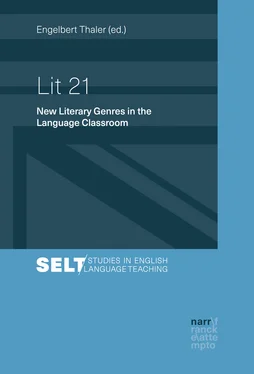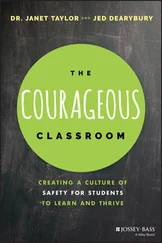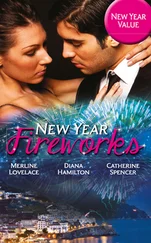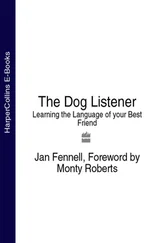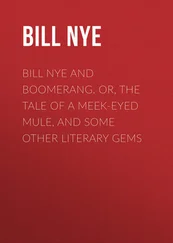Twitterverse can be a confusing place, especially when friends act differently online than they do in person. This painful insight is gained by Claire, a hopeless romantic, Lottie, who is determined to set up her BFF with Mr. Perfect, and Will, who wants his secret crush to finally notice him. Tweet Heart , a text-talk novel written entirely in emails, tweets and instant messages, is recommended by Eduard Gitt.
Anja Wahler introduces us to the innovative text type of digi fiction, i.e. fiction written for and read on a computer screen, combining visual, auditory and textual stimuli. The topics of immigration, intercultural encounters and refugees can be explored with the sample text of Flight Paths , which supports a multiliteracies approach in class.
The theoretical, methodological and practical contributions in this volume may open the doors a bit to accessing Lit 21 in our English language classrooms, so that we can strike a fair balance between pre-millennial fiction und post-millennial literature. As a matter of fact, there are not only the omnipresent DWEMs (Dead White English Males), but also the LANGs (Living Authors and New Genres). Cuncta fluunt.
A. Theory
Lit 21 – Teaching Post-Millennial Literature
Engelbert Thaler
Panta rhei . The world is in motion. So is literary production. And TEFL has to reflect that. Addressing the topic of this paper, one should adopt a five-step approach: What is the 21 stcentury like? Who are the 21 stcentury readers? What are the features of 21 stcentury literature? What new literary genres can be identified in the 21 stcentury? And how should you teach these genres in the 21 stcentury language classroom?
Attempting to summarize contemporary developments is bound to be both a challenging and selective endeavour. The following seven trends, which are highly interrelated, have affected literary studies and teaching literature to a considerable degree.
Globalization:It is a truism to state that today’s world is an increasingly transnationally configured one. “Indeed, globality seems to emerge as the new mega paradigm, superseding even post-modernism and post-structuralism, while transcultural studies are taken for granted in most disciplines today” (Gohrisch/Schmidt-Haberkamp 2017: 211). It is also a dialectical platitude that modern phenomena both have their blessings and drawbacks – or as the Indian-American literary scholar Spivak (2011: 1) in her seminal essay proclaimed: “Globalization takes place only in capital and data. Everything else is damage control.” This damage control ensues in numerous fields, whether in migration, law, police, identity formation, education, or teaching.
Digital Era:The process of converting information into a computer-readable format, where the information is organized into bits, is also changing TEFL methodology. Tools of digital transformation such as computer, Internet, smartphone, digital camera, projectors, and the IWB (interactive whiteboard) provide students with a widespread availability of authentic resources, the chance to communicate with people online in- and outside the classroom (extra-mural English), and a huge variety of learning apps on the go; teachers can access digital platforms, make use of online corpora, profit from online CPD (continuous professional development) and the global staffroom (Lütge 2018). However, long before digital media entered the classroom, Albert Einstein already demanded in his famous dictum: “The human spirit must prevail over technology” – and, more recently, the popular computer scientist Jaron Lanier (2018) proposed “10 Arguments for Deleting Your Social Media Accounts Right Now.”
Visual Turn:The humanities have also witnessed a pictorial or iconic turn (Boehm/Mitchell 2009). The linguistic turn is challenged by the visual turn ( imagic turn , visualistic turn ), in which the picture has dethroned the written word. Today’s world, more than ever, is determined by visual artefacts, and the image seems to have thrown the letter from its pedestal.
Multiliteracies:As we seem to have a paradigm shift every second day, we are also facing a multi-modal turn, in which “sit-back” media are increasingly substituted by “lean-forward” media. “In the 21st century, meaning-making is multi-modal in orientation with different semiotic systems interacting in complex ways” (Delanoy 2017: 13). In the mid-1990s, The New London Group (1996) coined the term Multiliteracies to describe an approach to literacy theory and pedagogy which, apart from linguistic diversity, highlights multimodal forms of linguistic expression and representation. A words-only approach has become outdated because “written-linguistic modes of meaning interface with oral, visual, audio, gestural, tactile, and spatial patterns of meaning” (Kalantzis/Cope 2012: 2).
Multi-optionality:A variant form of the affluent society , the multi-optional society reflects the profound influence technology has had on society, as consumers are accustomed to having everything literally at their disposal. In our Multioptionsgesellschaft (Gross 1994), “nothing is impossible”, everybody has the right to demand more and better things, for which Gross has coined the neologism “Mehrgott” (1994: 366). Multi-optionalisation increasingly affects every domain of life: consumption, ownership, work, family, relationships, education – and reading. With the decrease of traditional obligations, a space has opened for the individualisation in society, “Why not?” and “I construct myself” have advanced to the most frequently heard mantras in a multioptional I-society .
Diversity:Another mega-trend can be observed in the growing respect for group differences, whether they refer to race, ethnicity, age, gender, religion, physical health, socioeconomic background, sexual orientation, mental health, personality, or behaviour. Terms like superdiversity and intersectionality reflect the fact that these categories overlap in various forms (Walgenbach 2014). The acceptance of diversity is connected with cosmopolitanism (or multi-/transculturalism ), which claims that all human beings belong to a single community, and individuals from different areas and domains form relationships of mutual respect. Political creeds supporting the notion of diversity being desirable are convinced that promoting these diverse cultures will aid communication between people of different backgrounds. Critics of diversity voice concerns, among others, about the buzzword character of the term (bandwagon hopping), PC excesses ( Political Correctness ), or the oppression of the silent majority (Thaler 2016a).
World risks:“The time is out of joint. O cursed spite that ever I was born to set it right!” ( Hamlet I, v). What Shakespeare’s protagonist bemoaned more than 450 years ago, has lost nothing of its significance. With his concept of the world risk society , Beck, however, distinguishes between the ‘old risks’ and the ‘new risks’: “Old risks (industrial accidents, wars) and natural catastrophes (earth-quakes, tsunamis) overlap and are becoming associated with new risks (catastrophic climate change, global financial crises and suicide attacks) and thus can trigger in turn new, incalculable and unpredictable turbulences” (Beck 2012 [2009]: 19). The contemporary Hamlet has to set right calamities like a tremendous global population increase, mass migration, terrorism, religious clashes, global warming, vanishing cropland, extreme poverty, economic crunches, impeding shortages of fresh water, oil and other natural resources, just to name a few. In the 21st century “crisis” may be the new “normal”.
Читать дальше
